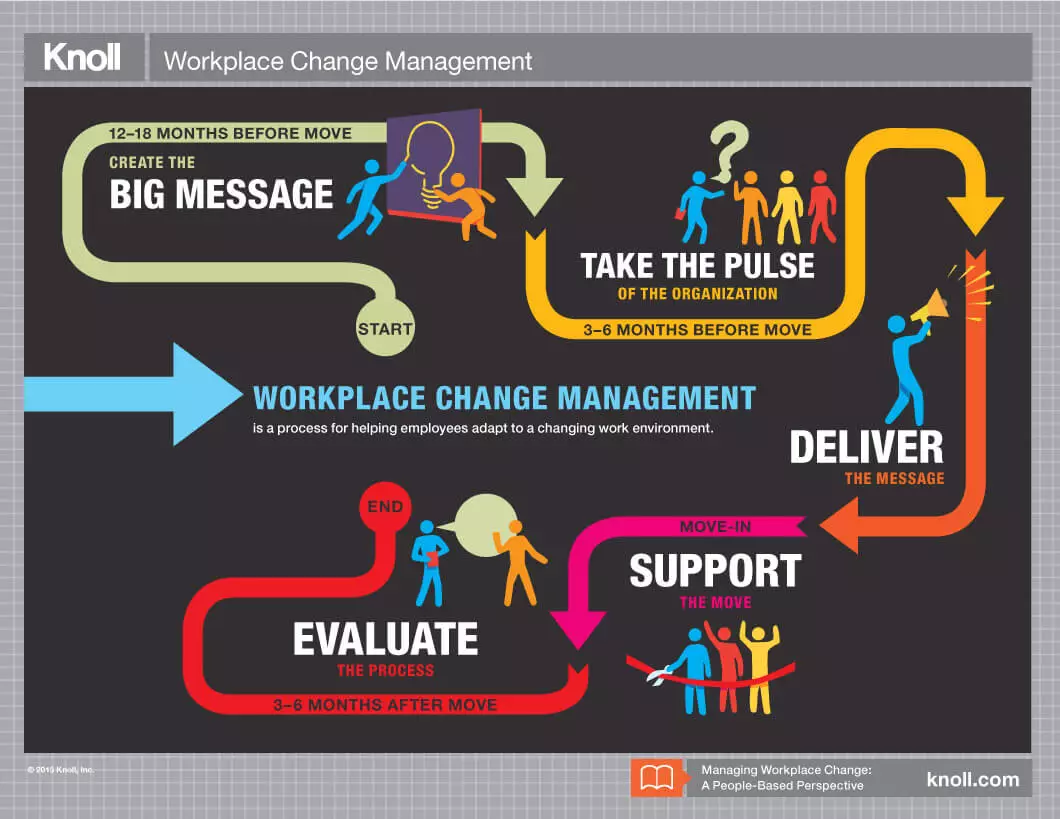
Change management is an evolving concept which is here to stay. Change has become more prevalent across industry, so companies must get creative if they’re to manage it effectively in 2019.
Change without effective management can cause disruption, especially with the frequency and complexity of change in today’s digital landscapes.
The Building Blocks That Make #DigitalTransformation Such a Compelling Value Propositionhttps://t.co/tud10dT0e1 v/ @simplilearn#BigData #Cloud #AI #CX
Cc @evankirstel @psb_dc @antgrasso @MarshaCollier @akwyz @andi_staub @guzmand @ahier pic.twitter.com/15Oqh7TkSS
— ipfconline (@ipfconline1) October 1, 2018
Source image: knoll
Many people are frustrated by the prospect of change, despite the exciting prospects it often brings with it. Change is frowned upon because it threatens the environment people have grown accustomed to.
Anything which challenges the status quo is perceived as negative, even when change can revolutionize organizational procedures. The potency of change has lots to do with the extent staff accept it.
That means the behavioral mindset of your team is critical. If staff have a reluctance to embrace change, change management should focus on converting attitudes to embody a more positive outlook.
The people side of change is evolving considerably, where companies are beginning to realize the importance of incentivizing those who drive change.
There are technical considerations too, but with an all-encompassing approach to change management for 2019 you’ll have all bases covered.
Change is a challenge, but it’s important to create a culture which doesn’t automatically reject the unknown. Positive change must win out, so you can avoid wasting energy and valuable resources.
Change management continues to evolve, and though we can’t predict next year’s horizon exactly, we can hazard a fair estimate.
If you’re interested in learning how to approach change management for 2019, you’ll appreciate these steps to success:
Change Management For 2019: 4 Steps to Success
1. Acknowledging the Need to Change
Successful change starts with recognition. This is the first step towards transcending business operations, where you discover an opportunity for improvement.
This opportunity should be welcomed with open arms. The prospect of transforming a business process is an exciting one, which wouldn’t come about without an acknowledgement to change.
Understanding the need to change is a progressive step, one which shouldn’t be solved with a quick fix solution. Resist the urge, take a step back, and communicate and evaluate your desires accordingly.
You can involve a range of people in development, especially those positioned to play an integral role. There are various tools and techniques on hand to help, which will help you identify relevant parties and understand change in greater detail.
“It is tempting to believe that organizational change is easier to achieve within a strictly hierarchical structure, but social network theory tells us otherwise” https://t.co/MBbXGesifU via @Forbes #networks #changemanagement
— Kelly Hoey (@jkhoey) September 4, 2018
2. Communication
Once you’ve explored the concept of change with invested parties, it’s time to communicate your ambitions.
This is a crucial stage for getting your team on board, while ensuring everyone is united on the same page. When everyone appreciates the importance of change, they’ll be motivated to embrace it.
Change should be discussed as essential for growth, with benefits that can be enjoyed by staff of all volitions.
Consider what other staff value, and how change will influence their daily duties. If you can communicate change as fitting with company culture, you’ll be better positioned to influence your team.
When you begin to proactively involve other staff there are various challenges to consider. These typically require more time and resources, and can generate frustrations organization-wide.
If you can circumnavigate issues, and perhaps even provide a reassuring word on the timeline for change, staff will be more receptive.
Change should never be rushed, otherwise problems can rear their ugly head at a later stage as staff commitment weakens.
3. Change Plans
Once your change ambitions have been communicated, it’s time to sink your teeth into real action. This involves educating your staff accordingly, teaching them the tools and techniques they need to be successful.
With everyone on the same page, you’ll be positioned to develop a change procedure which significantly enhances business operations.
Your change plan should be in depth, outlining an end goal, your milestones leading up to that goal, and the timeline for change.
Detailing where you want to be in said time is a great place to start. This will give you a clearly defined route to success, one which should of course be subject to the volatility experienced across business landscapes.
Your plan should be thorough, incorporating precise measures and objectives. Specify what you want to achieve from your framework, and use this as ambition to achieve great things.
The planning stage can take a long time, but change is a marathon, not a sprint. Patience is a virtue, and you can’t expect an overnight transition.
Once you’ve finished planning your route to success, it’s time to implement your plan. This is essentially the execution of change, where everyone is clear on their goals and responsibilities.
Everyone will understand their role in the change, and they’ll need to be supported through the uncertainty of things.
Maintain some form of routine, and manage stress with a reassuring voice. You can use different metrics to measure the success of change, while tweaking your approach according to real life results.
Managing your team’s reactions is important, while mitigating unexpected circumstances. Promote a positive approach to change with an understanding attitude.
Your plan should be promoted with continuous improvement at the forefront. It will be a work in progress, but an unpolished work of art that will one day be a gem.
4. Celebrate Success
It’s important to celebrate wins early and often. When staff behave favorably and change goals are continuously met, you should celebrate the success.
A great way to celebrate success is with fun games and activities!
Celebrating early and often is important for team morale, and to keep your team moving in the right direction. They will be incentivized to work in conjunction with change goals, especially if you continue to reinforce their positive actions.
Thank people for their hard work, and perhaps even acknowledge their efforts with bonuses and/or prizes.
WalkMe Team
WalkMe spearheaded the Digital Adoption Platform (DAP) for associations to use the maximum capacity of their advanced resources. Utilizing man-made consciousness, AI, and context-oriented direction, WalkMe adds a powerful UI layer to raise the computerized proficiency, everything being equal.




